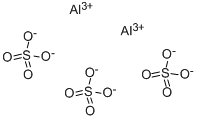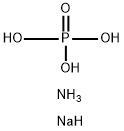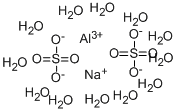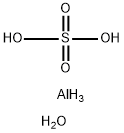SODIUM ALUMINUM SULFATE
- CAS NO.:10102-71-3
- Empirical Formula: AlNaO8S2
- Molecular Weight: 242.1
- MDL number: MFCD00040660
- EINECS: 233-277-3
- SAFETY DATA SHEET (SDS)
- Update Date: 2024-12-18 14:07:02

What is SODIUM ALUMINUM SULFATE?
Chemical properties
Colorless crystals; saline, astringent taste; effloresces in air. Soluble in water, insoluble in alcohol. Noncombustible.
The Uses of SODIUM ALUMINUM SULFATE
Sodium Aluminum Sulfate is a leavening agent that releases the majority of the gas during baking, and is not used alone but in com- bination with a faster-acting leavening agent such as monocalcium phosphate. this results in a double-acting baking powder. it is almost nonreactive until heat is applied. it is used in baked goods.
The Uses of SODIUM ALUMINUM SULFATE
Aluminum Sodium Sulfate is a general purpose food additive that functions as a buffer, neutralizing agent, and firming agent. It is anhydrous and slowly soluble in water. The dodecahydrate form is readily soluble in water. It is also termed soda alum.
General Description
A colorless crystalline solid. Used in textiles, paper making, water purification, food processing.
Air & Water Reactions
Solid effloresces in air. Water soluble.
Reactivity Profile
SODIUM ALUMINUM SULFATE gives acidic solutions in water.
Health Hazard
Inhalation of material may be harmful. Contact may cause burns to skin and eyes. Inhalation of Asbestos dust may have a damaging effect on the lungs. Fire may produce irritating, corrosive and/or toxic gases. Some liquids produce vapors that may cause dizziness or suffocation. Runoff from fire control may cause pollution.
Fire Hazard
Some may burn but none ignite readily. Containers may explode when heated. Some may be transported hot.
Safety Profile
A weak sensitizer. A general-purpose food addtive. Local contact may cause contact dermatitis. An irritant. See also SULFATES and ALUMINUM COMPOUNDS. When heated to decomposition it emits toxic fumes of SO, and Na2O.
Properties of SODIUM ALUMINUM SULFATE
| Melting point: | ~60℃ [MER06] |
| Density | 1.610 |
| solubility | insoluble in ethanol |
| form | colorless crystals |
| color | colorless crystals, crystalline |
| Water Solubility | g anhydrous/100 g H2O: 37.4 (0°C), 39.7 (20°C), 43.8 (40°C) [LAN05]; insoluble alcohol [MER06] |
| CAS DataBase Reference | 10102-71-3 |
| EPA Substance Registry System | Aluminum sodium disulfate (10102-71-3) |
Safety information for SODIUM ALUMINUM SULFATE
Computed Descriptors for SODIUM ALUMINUM SULFATE
SODIUM ALUMINUM SULFATE manufacturer
Ultra Chemical Works
H. K. Group
New Products
(S)-3-Aminobutanenitrile hydrochloride 4-Methylphenylacetic acid N-Boc-D-alaninol N-BOC-D/L-ALANINOL Tert-butyl bis(2-chloroethyl)carbamate 3-Morpholino-1-(4-nitrophenyl)-5,6-dihydropyridin- 2(1H)-one Furan-2,5-Dicarboxylic Acid Tropic acid 1-Bromo-3,5-Di-Tert-Butylbenzene S-2-CHLORO PROPIONIC ACID ETHYL ISOCYANOACETATE 2-Bromo-1,3-Bis(Dimethylamino)Trimethinium Hexafluorophosphate 4-IODO BENZOIC ACID 3-NITRO-2-METHYL ANILINE 1-(2,4-DICHLOROPHENYL) ETHANAMINE (2-Hydroxyphenyl)acetonitrile 4-Bromopyrazole 2-(Cyanocyclohexyl)acetic acid 4-methoxy-3,5-dinitropyridine 1-(4-(aminomethyl)benzyl)urea hydrochloride 2-aminopropyl benzoate hydrochloride diethyl 2-(2-((tertbutoxycarbonyl)amino) ethyl)malonate tert-butyl 4- (ureidomethyl)benzylcarbamate Ethyl-2-chloro((4-methoxyphenyl)hydrazono)acetateRelated products of tetrahydrofuran








You may like
-
 Sodium Aluminium Sulphate 99%View Details
Sodium Aluminium Sulphate 99%View Details -
 10102-71-3 99%View Details
10102-71-3 99%View Details
10102-71-3 -
 1975-50-4 98%View Details
1975-50-4 98%View Details
1975-50-4 -
 2-HYDROXY BENZYL ALCOHOL 98%View Details
2-HYDROXY BENZYL ALCOHOL 98%View Details
90-01-7 -
 2-Chloro-1,3-Bis(Dimethylamino)Trimethinium Hexafluorophosphate 221615-75-4 98%View Details
2-Chloro-1,3-Bis(Dimethylamino)Trimethinium Hexafluorophosphate 221615-75-4 98%View Details
221615-75-4 -
 61397-56-6 CIS BROMO BENZOATE 98%View Details
61397-56-6 CIS BROMO BENZOATE 98%View Details
61397-56-6 -
 14714-50-2 (2-Hydroxyphenyl)acetonitrile 98+View Details
14714-50-2 (2-Hydroxyphenyl)acetonitrile 98+View Details
14714-50-2 -
 118753-70-1 98+View Details
118753-70-1 98+View Details
118753-70-1